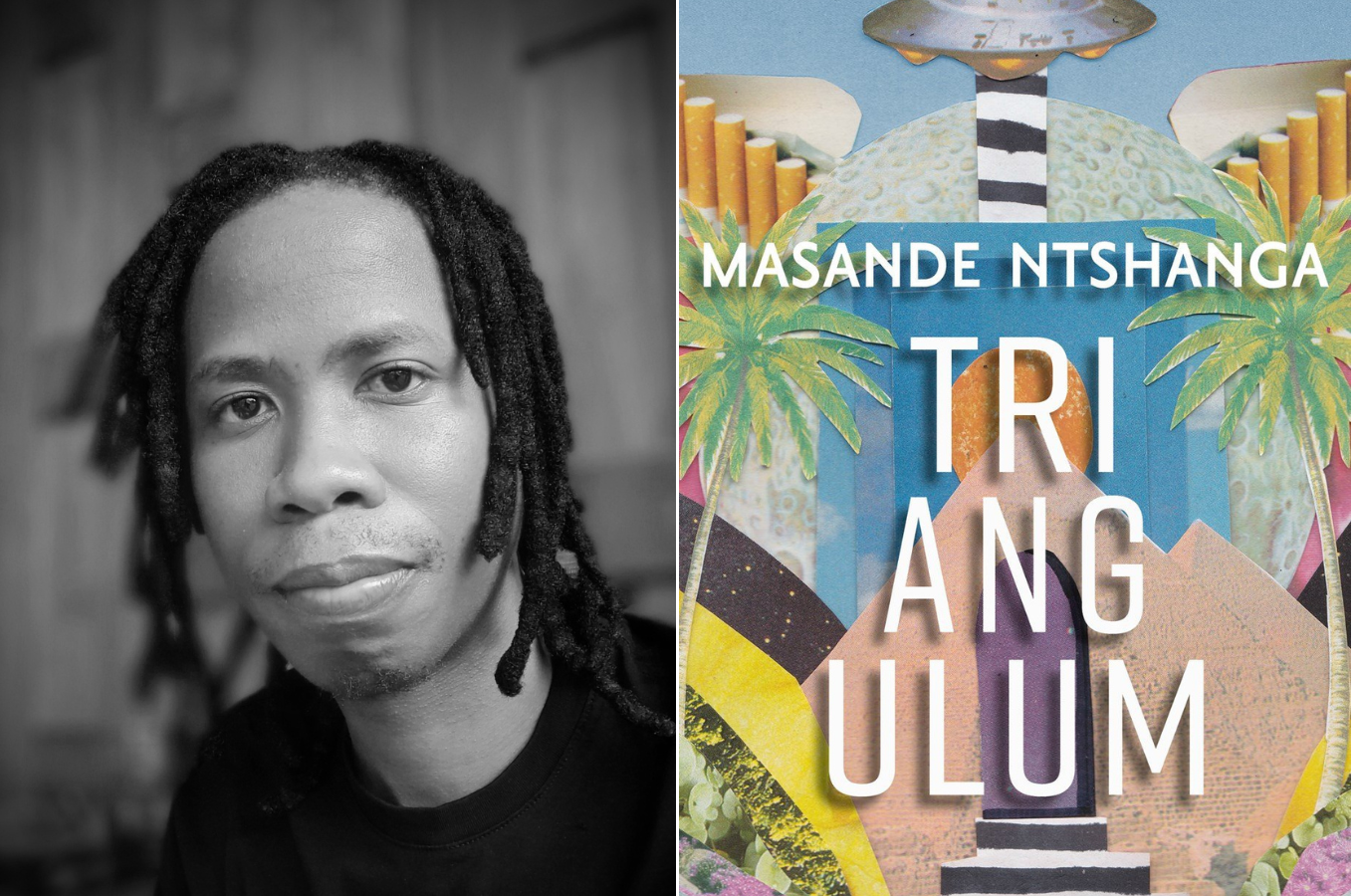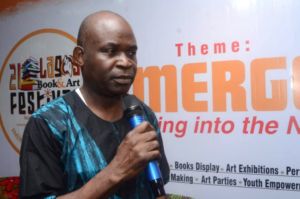
Masande Ntshanga’s Triangulum begins with a message from the future. An explosion has occurred on the face of Table Mountain, predicted, we soon learn, by manuscripts and audio recordings produced long before the incident, sent to the South African National Space Agency. The character who has chronicled this work is anonymous. The very genesis of this novel leads to the question: What does it mean to receive a message from the future? Even in the world of science fiction, that particular experience is significant for one writing as a black person within the Southern African context.
Triangulum is a first-person account of an unnamed teenage maths prodigy who struggles with her mother’s disappearance during the demise of the homeland system, in what used to be known as King William’s Town. She is visited by what she calls “the machine” and believes this to be a signal from her mother that is connected to the recent abductions of local girls. The novel follows her into adulthood, where she becomes a data scientist. Ntshanga’s subsequent text, Native Life in the Third Millennium, is written in three movements — a postmodernist collection of poetry/prose that is concerned with black existence through time. For this essay, it is the third act, “quiet earth philosophy,” that is the main point of intrigue. The themes in these texts are varied, but the most striking is the consistent undercurrent of Southern African ancestral spirituality for which Ntshanga has written allegories.
The concept of what is termed “speculative fiction” being an allegory for the spiritual is not new. Lauren Olamina’s “Earthseed” religion as presented in Octavia Butler’s Parable of the Sower, sees destiny as “to take root among the stars”. It is one among many science-fiction works that have considered what life exists outside of the realm we occupy — even if the approach is so cerebral that the language must be about planets outside of Earth, as opposed to different dimensions within Earth. It would not be difficult to locate the Oregenes of N. K. Jemisin’s The Fifth Season and their ability to control energy — as well as their subsequent persecution — in a myriad of histories that have seen those who have so-called supernatural talents persecuted. Yet there is clearly an undercurrent of African ontologies by Ntshanga that distinguish him from the Afrofuturist label often assigned to him.
When Nnedi Okorafor disavowed “Afrofuturism” as a term for African writers of science fiction, she proposed the term “Africanfuturism” as a subgenre more embedded in African cultures, histories, and mythologies:
Africanfuturism is concerned with visions of the future, is interested in technology, leaves the earth, skews optimistic, is centred on and predominantly written by people of African descent (black people) and it is rooted first and foremost in Africa. It’s less concerned with “what could have been” and more concerned with “what is and can/will be”. It acknowledges, grapples with and carries “what has been”.
Ntshanga clearly thinks about what has been. The creation of a dystopian setting where the colonial dispossession and abandonment of King William’s Town — Ntshanga’s hometown — haunts the protagonist of Triangulum is testament to his location within history. “The book is about being an alien in your own occupied territory,” Ntshanga tells me. “Colonialism, apartheid and technology as an instrument of conquest.” Then how the novel thinks about the future and the prophecy destruction of the planet speak to what can/will be. This also emerges in ‘quiet earth philosophy’ — where the protagonist meets with the engineer to imagine the future of humanity’s existence.
Now, as a sangoma, it is most significant to me that Okorafor acknowledged in the blog that “Africanfuturism (being African-based) will tend to naturally have mystical elements (drawn or grown from actual African cultural beliefs/world views, not something merely made up).”
The acknowledgement that, while it is distinct from what she calls Africanjujuist writers, the Africanfuturist writer will draw on African beliefs that makes it possible for these particular projects to live within Africanfuturism. Ntshanga thinks deeply about existence within the understanding of the structures that affect the individual. But, in the tradition of the writers among which he lives, he also thinks about existence beyond the earthly iteration of our being, and technology is the tool with which he does this.
The Technology of the Ancestral
There is a drive to use technology to reach a higher level of consciousness or existence — or sometimes to regress to the most dystopian parts of existence — that underlies the undertaking of sci-fi production. And the characterisation of that undertaking as more cerebral than esoteric is owed to the epistemological dominance of western ideology at the expense of Indigenous Knowledge Systems. Therefore, thinking through these texts as allegorical of Southern African spirituality is a good way to go towards the expansiveness of the methods through which we can seek a higher level of consciousness. In Native Life in the Third Millennium, the engineer’s ‘quiet earth philosophy’ “understands that in order to survive, humankind will have to evolve to forfeit corporeal existence and continue on as a simulation of consciousness, hovering over a quiet Earth of transistors, powered through the planet.”
The engineer states that “if the idea is seeded now, we believe, it will flower on its own amongst posthuman philosophers in three centuries, under a different name, and will culminate in a movement to rehost human consciousness inside brain tissue, safeguarding a second transition: the return of the reconfigured living, breathing organism.” Here, Ntshanga seeks an evolution of human consciousness through technology. But, for those of us who work with different realms within Southern African ancestral healing, the technology is different. In Xhosa healing, the ancestors who call one to become igqirha — an experience that finds no adequate translation in the English language — are called “amathongo.” This is drawn from the word “ubuthongo” which speaks to a deep sleep. Therefore, “ithongo” is an ancestor that had been ‘sleeping’ (in ‘death’) for a while before they awakened to call upon the individual through which they will work to heal others. ‘Quiet earth philosophy’ speaks to this experience; old, ancestral beings who “forfeit corporeal existence” as their bodies die and whose consciousness is re-hosted in our bodies as amagqirha/izangoma/izinyanga.
In Triangulum, I am enamoured with Ntshanga’s attention to time; first, the character’s inquiry into the possibility of time travel, and the subsequent clarity that she is first offered by the scientist, and then later by the machine itself. When she finally encounters the machine, it is explained to her that, “[t]he human mind comprehends existence through three dimensions: the past, the present and the future,” and further, “this is not the case with our kind, as our comprehension is not fixed to a shape.” All this is a summation of what it means to live in the present, predict the future through being a conduit for beings from the past.
Madness in the Ancestral
In Triangulum, the allegory emerges from the idea of the girl whose whole life is haunted by the sight of The Machine. It is clear from the beginning that delusion as a conclusion does not work, and yet the dance between what the truth is and what is delusion is quite delicate. The protagonist grows up seeing this machine in the form of a triangle, often accompanied by a blackout from experiencing the apparition.
As a sangoma who exists in a world where our experience of the ancestral calling is immediately identified through the language of psychiatry, my Bible is Robert Edgar and Hilary Sapire’s African Apocalypse: The Story of Nontetha Nkwenkwe, A Twentieth Century Prophet. Edgar and Sapire highlight the violent history where mental asylums functioned as prisons for “deviant” people during colonial administration in South Africa. Furthermore, they write about how people who experienced symptoms that had been associated with delusion, such as hearing voices and seeing things, would be misdiagnosed as schizophrenia or some other pathology. Reading the experiences of Ntshanga’s protagonist in Triangulum invokes these memories and makes one wonder if her experience is not being misrecognised by the author himself. In the end, when she finally encounters the machine, it becomes clear that while she misunderstood the message, the machine was indeed there. It speaks to her as ten voices in one, saying:
Humankind is host to an organism it has termed Evolution. It is benign and acts to preserve sentient life on Earth. That is what we know. It is our understanding that it has intervened, but it is unclear, as our kind does not evolve. It is our understanding that the mother was the first to hear us, and she passed this on to the daughter. In those who are receptive, our voice provides them with both gifts and illness, but never comprehension. That is, until you and your mother.
The idea of gift and illness, of an experience that is hereditary (ancestral), coupled with the idea of these beings not having a fixed experience of time and existence (therefore being able to exist in all these dimensions at once) ties it all together neatly.
Medicine in the Ancestral
The unnamed protagonist of Triangulum serves as a stand-in for those of us who, knowingly or not, experience the ambiguous madness of the calling. In childhood, her relationship with plant medicine is characterised by scepticism. There is an instance where she needs medication for dysthymia, and her father begins by seeking a herbal specialist. Her response to this is to perceive her father as always accepting these solutions with what she calls ‘a premature sense of gratitude’. Later, when the father is ill, his sister tricks them into thinking they are going to see a herbalist and instead takes him to a biomedical doctor. Now, the dichotomy in how Ntshanga writes this — the younger, missionary-educated black person who disavows indigenous healing solutions, and the father who leans too hard on them at the expense of his own health — closes the door on the medical pluralism that characterises how many South Africans engage with their healing.
Kukud’ eBhofolo, Indawo Yamageza
I use Zim Ngqawana’s rendition of the Xhosa healers’ song “eBhofolo” to illustrate the cognisance that those of us who work with the ancestral — who have historically been described as mad — are indeed mad. Tower Pyschiatric Hospital in Fort Beaufort, called eBhofolo in isiXhosa, was historically used as a mental asylum for natives only, and Nontetha Nkwenkwe, who is mentioned briefly as a prophetess above, was incarcerated in this hospital in 1922. The only logical conclusion I can draw is that Xhosa healers sing this song, “kukude eBhofolo, indawo yamageza” (eBhofolo, the place of the mad, is far) because whether it is misrecognition or not, there is always a dance with madness when we consider the Southern African world of ancestral healing and prophecy.
Towards the end of Triangulum, Ntshanga invokes the story of Nongqawuse, the young Xhosa girl (often referred to as a prophetess) who claimed to have gone near the river and heard from the ancestors that the Xhosa people should kill all their cattle and burn all their crops so that the dead would resurrect to help them fight the colonial administration. The aftermath of which was conflict, famine, and death. The protagonist wonders if she and Nongqawuse are alike, dancing closely to the edge of delusion. But the language surrounding who Nongqawuse was according to South African isiXhosa terms of ancestral healing (igqirha, ixhwele, umthandazi) is unclear — so perhaps they are indeed alike, as the anglicised character is too removed from her indigenous spirituality to understand the message, and Nongqawuse too obscure and misguided.
Ntshanga is ambivalent about most titles and characterisations of his work; speculative fiction writer, Afrofuturist writer —having experienced this aspect of his writing as “closer to cyberpunk as a subgenre,” as he clarifies for me, “which I loved growing up.” Locating the texts within different parts of the canon is the reader’s endeavour, dependent on the angle one is trying to think through. However, it is glaring that, in these works, Ntshanga creates an Africanfuturist sci-fi parable through which we can decode the ancestral.
Photo by cottonbro studio from Pexels










COMMENTS -
Reader Interactions